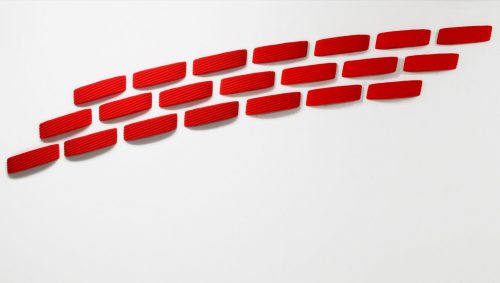Pino Pinelli
Pittura R
“I frammenti si dispongono sulla parete quasi a mimare il gesto del seminatore. La visione è un elemento essenziale del mio lavoro, ma c’è anche un coinvolgimento tattile, sensoriale che invita a: toccare, sentire, vedere. Certamente l’arte è pensiero. Pensare e fare. Fare e pensare”.
Dono dell’artista. Tecnica mista, disseminazione di 21 elementi, 2011, cm 36 x 10 ciascuno.
Resume navigation
Nato a Catania nel 1928, vive e lavora a Milano.
Dopo essersi formato a Catania, si trasferisce a Milano nel 1963, attirato dalla presenza di un vivace centro artistico. È tra i maestri della Pittura Analitica, un movimento pittorico che si sviluppa negli anni Settanta con l’intento di indagare le componenti materiali della pittura – come il colore e la tela – e il rapporto tra la materia e il suo autore. In questo senso, Pinelli fa scelte stilistiche che lo portano alla destrutturazione del quadro e a lavorare sulla superficie e sugli spazi. Le sue opere sono caratterizzate dall’abbandono della tela, a favore dell’utilizzo di materiali che esprimono un’elevata qualità tattile (flanella e velluto), e sono costituite dalla combinazione di più elementi pittorici, come sagome geometriche e monocrome che seguono un percorso predeterminato dando luogo alle cosiddette “disseminazioni”, dove la pittura, ridotta a frammenti, si colloca sulla parete mimando il gesto del seminatore, in una sintesi tra spazio e pittura.
Pino Pinelli
Pittura R
“Fragments are placed on the wall as if to mimic the gesture of the sower. Vision is an essential element of my work, but there is also a tactile, sensory engagement that invites you to: touch, feel, see. Certainly art is thought. Think and do. Do and think.”
Donated by the artist. Mixed media, dissemination of 21 elements, 2011, 10 x 36 cm each.
Resume navigation
Born in Catania in 1928, currently he lives and works in Milan.
After training in Catania, Pino Pinelli moved to Milan in 1963, attracted by the presence of an artistic centre. Among the masters of Analytic Painting (a pictorial movement developed in the 1970s with the intent of analysing the material components of painting – such as paint and canvas – and the relationship between the material itself and the artist), Pinelli adopted stylistic choices that led him towards a destructuring of the painting to work on the surface and spaces. His works are in fact characterised by the abandonment of the canvas, in favour of the use of materials that convey a high tactile quality (flannel and velvet), and are made up of the combination of several pictorial elements, such as geometric and monochrome shapes that follow a predetermined path, giving rise to his so-called ‘broadcasting’ technique where the painting, reduced to fragments, is placed on the wall to mimic the gesture of the sower, in a synthesis between space and painting.
